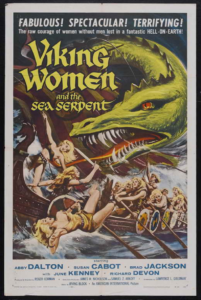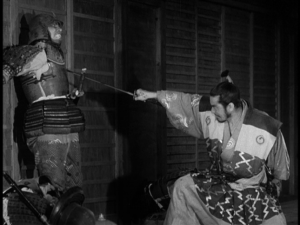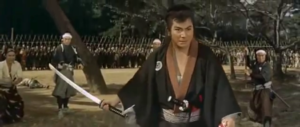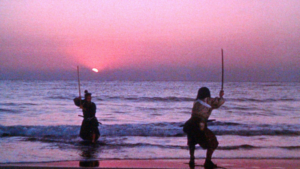Viking Women and the Sea Serpent
Viking Women and the Sea Serpent
Rating: *
Origin: USA, 1957
Director: Roger Corman
Source: Lionsgate DVD

Well, there went sixty-five minutes I’ll never have again. In the late fifties, movies about giant monsters were popular, many of them produced by the shlock-house of American International Pictures, and filming a bevy of half-clad starlets had never gone out of style, so producer-director Roger Corman combined the two in this miserable would-be epic. Its pompously-overlong full title is The Saga of the Viking Women and their Voyage to the Waters of the Great Sea Serpent, which is the only thing the least bit clever about this dud. In Norway, which you probably didn’t realize looks exactly like southern California, at a village whose men went off a-Viking and never returned, the women are voting on whether to go search for them by the traditional Nordic method of hurling their spears into the “Yes” tree or the “No” tree. The deciding “Yes” vote is cast by the priestess Inger, the only non-blonde, who is suspected of wanting to go on the mission so she can get her hooks into one of the missing men, a Viking who belongs to the blonde woman with the ponytail. (Since none of the blonde women have been granted distinctive personalities or dialogue, the only way to tell them apart is hairstyle.)
The women go to sea in a cheesy-looking fake drakkar, a prop so crappy that pieces are visibly falling off it as it’s launched. (Apparently the whole crew of Viking women damn near drowned when the guy piloting the tow-boat fell asleep and they were all carried far off-shore.) Once they’re at sea the only subject the women want to talk about is men, so you know this is a fantasy. Fortunately, the only man left in town, a shirtless blond surfer dude, has stowed away, so there’s somebody trustworthy on board who can make important decisions and deliver exposition like, “It’s the monster of the vortex!” Said monster is the worst sea serpent ever back-projected in Hollywood, but it’s monster enough to swamp the crappy drakkar, which for good measure is set afire by gratuitous lightning. The crew abandon ship, and we’re treated to the sight of a flaming six-inch model of an entirely different longship swirling down into a tiny whirlpool.
The crew wash ashore somewhere on the coast of Malibu, where they’re promptly captured by a tribe of mounted barbarians and marched off to an unconvincing matte painting of a generic castle. There the barbarian chief tells them with a leer that they are now slaves who must do whatever the barbarians wish—but first there must be a boar hunt, so the Viking women are given horses and spears, and off they all go. (Don’t ask about the sad fake-tusked porker that plays the boar.) The rest of the film makes just as much sense. There’s a rowdy feast with “exotic” dancing, gratuitous woman-whipping, escape, betrayal by Inger (never trust the dark-haired one!), recapture, reunification with the lost and enslaved Viking men, more escape, more recapture, and a flaming sacrifice of the Vikings to the barbarian gods that is dowsed in a literal deus ex machina when Inger redeems herself by calling on the god Thor to save them. That leaves only the final battle with the titular sea serpent, who has apparently been able to terrorize the coast of Malibu for generations because nobody ever thought to stick a sword into it. Well, I never.


